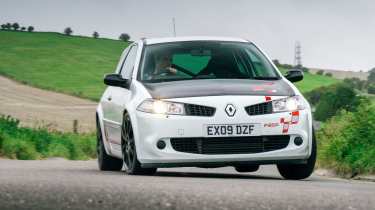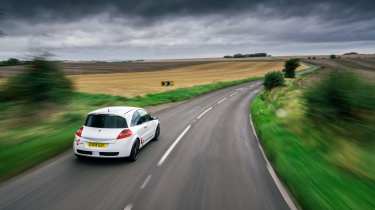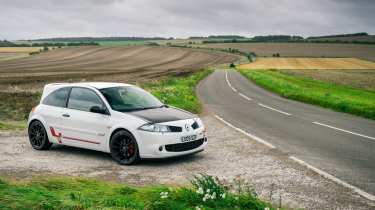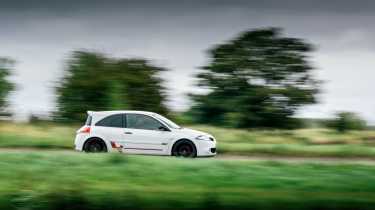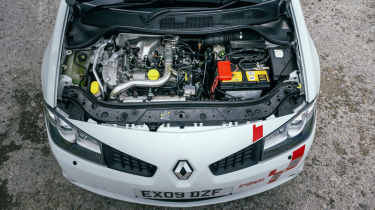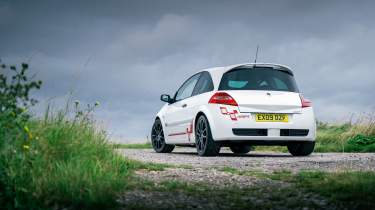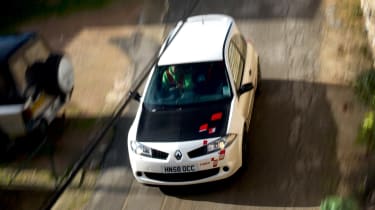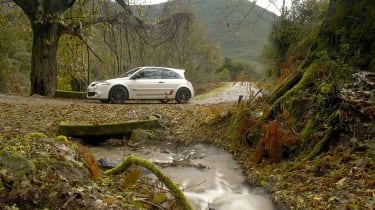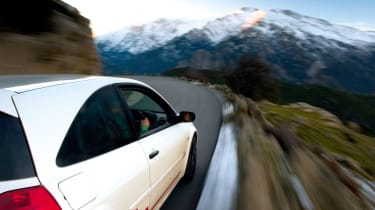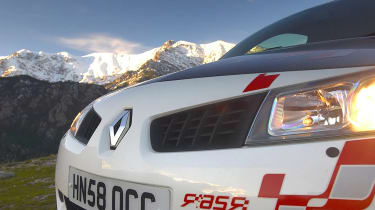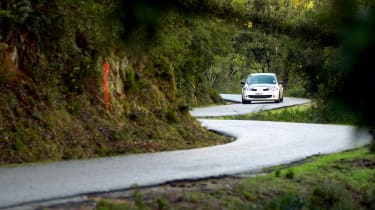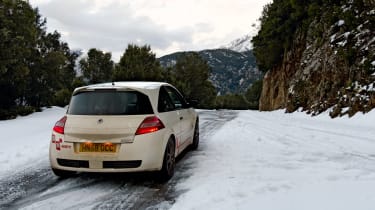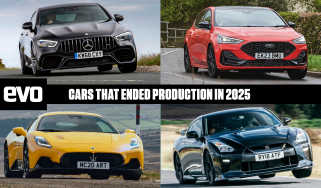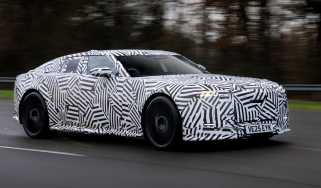Renault Sport Mégane R26.R (2008 - 2009) review – Dieppe's finest hour
The Renault Sport Mégane R.26R is undeniably one of the best hot hatches of the last three decades, if not the best
The Renault Sport Mégane R26.R is about as evo as it gets. Sure, out there, in the wider population, with their unfathomable blind spot for great roads, loveable cars and enthusiastic driving, the notion of a two-seat-only hatchback is an absurd one. A chocolate teapot. Expensive when new, the R26.R is an anathema to the masses who view cars as mere transport, with an inevitable dearth of appreciation for ageing, stickered-up French hatchbacks.
You, of course, know differently. You know it’s a giant-killer even to this day, some 16 years after its launch, and that it encapsulates everything that made a generation of machinery from its maker the standard bearer for relatively affordable performance cars. What you might not know is how the R26.R came into being, and how unlikely its birth looked at the time.
> Renault Sport Clio 182 Trophy (2005): review, history, prices and specs
Although he’s too modest to admit it, much of what we love about those Renault Sport cars – and indeed the Alpines that have followed – can be attributed to Jean-Pascal Dauce. The French engineer joined Renault back in 1991 and Renault Sport in 2000, his first project being the Phase 2 Renault Sport Clio V6. As he explains, Renault Sport tended to have one engineer lead the concept phase of a project, sometimes then switching to another to bring the car to production, followed by a different engineer to lead the developments over the model’s lifecycle. In the case of the RS version of the Mégane II, it was JPD who took over at the lifecycle stage.
More reviews
In-depth reviews
Reviews
- Renault Sport Mégane R26.R (2008 - 2009) review – Dieppe's finest hour
- Renault Megane E-Tech 2022 review
- Renault Megane RS 300 2021 review – less is more with this GTI rival
- Renault Megane RS sport chassis (2017-2020) review – forget the Trophy, basic is best with the Megane RS
- Renault Megane RS Trophy (2019-2020) review – is this Renault Sport’s redemption?
- Renault Megane RS cup chassis (2018-2020) review – sharp, even when you don't want it to be
- K-Tec Racing Mégane review - Renault Sport's impressive hot hatch gets 360bhp
‘We were not 100 per cent happy with this car at the start,’ he recalls, ‘because it was a bit of luxury and a bit of sport. Some people were saying, “A Clio 172 Cup we know what it is, but a Mégane RS we don’t know. What are you standing for?” And two or three topics we were not very comfortable with, especially the electric power steering. So the car as launched was not perfect, let’s say.’
It was clear at the time that Renault was expanding the segment’s horizons, latching onto the concept of the Mk1 Ford Focus RS (with its front-wheel drive and 200bhp+ turbo motor) but exceeding its power level and offering a greater bandwidth of abilities. Then there was the sheer eccentricity and individualism of the styling inside and out: the ‘bustle back’, the key card – it was a car that made an immediate impression, in spite of a few flaws. Yet what followed really put Renault Sport on the map, building on the success of the hot Clios that had taken over the smaller hot hatch class from Peugeot/Citroën.
The Mégane evolved rapidly, with Trophy, Cup and ‘F1 Team R26’ variants that each dialled-up the evo factor. It was no accident. JPD and his team were initially afraid to lose the more luxury-minded customers, but the reality turned out to be different – the Méganes were attracting enthusiasts who were moving up from Clios. ‘The more we were putting sportiness in the car, the more the awards came from the press and customers, so of course it gave us more energy to do the R26, which I was very proud of. It was exactly the car we wanted to do.’ The R26 was indeed a belter, the Mégane II reaching full maturity, but how best to send off this generation of Mégane?
‘After having some evo Car of the Year success in the sporty world with the R26 we became a bit more… let’s say “happy”,’ Dauce continues. ‘That’s how the R came about – four of the guys in my team, including me – we were a bit enthusiast.’ He chuckles at the glaring understatement. ‘We proposed that rather than do a limited edition, which we usually call “bye-bye” – just do a body colour and two or three small bits – we drafted something a bit crazy. So I went to see my boss and said, “Rather than do this not very interesting bye-bye edition, we could spend that money on a proof of concept. If you don’t care for the concept we do nothing; no one can buy a limited edition but we don’t need it. If you are happy, we have no more money, so you find the money and we can make something a bit exciting…’
> BMW M3 GTS vs Mini GP vs Renault Sport Mégane R26.R
The R project was essentially a big gamble. Dauce took a small team and shut himself off from the rest of the company, knowing timing was everything. He had three months, and not a day longer, because the factory in Spain where all Mégane II bodyshells were being made was switching tooling to the Mégane III in the summer of 2007, and that would wait for nothing, especially not a tiny project of just 450 cars.
The result was a car focused entirely on driving, and at its core one that prioritised increased performance through a reduction in weight. Dauce was told that any power increase was out of the question, because the forthcoming RS250 based on the Mégane III would have its marketing undermined by a run-out model offering similar power. Hence the considerable and radical weight saving – 123kg, achieved by both leaving stuff out and looking for more exotic solutions.
As Dauce attests, two of the project’s biggest challenges were the carbonfibre bonnet (saving 7.5kg) and Lexan rear side glass and screen (5.7kg), which entailed working with new materials and ensuring quality was consistent for a production application. There was also the option of a titanium exhaust (£2250) and the fitment of lighter wheels, shod with the other big R performance enhancement: semi-slick Toyo 888 tyres. The R26.R didn’t go through the usual Renault durability programme in various climates, because the engineers felt it was close enough to the R26 to not require it, but plenty of work was carried out to ensure the Toyos weren’t lethal in the wet, including tests with French journalists.
Out went the rear seats, the front fog lights, the passenger and curtain airbags, and the audio system. The exterior mirrors were now manually operated, not electrically. £700 brought a half cage in the rear and the sticky Toyos, while the Sabelt bucket seats (saving 25kg) were combined with five-point Sabelt harnesses (and the removal of the inertia-reel belts). In fact, the harnesses provided perhaps the biggest headache of all, because the team had to convince Renault’s homologation department that a twist motion to release was the same movement as pressing a button. Fun fact: want to tell a Swiss-market R26.R from all the others? It has a push-button harness made by Schroth instead of the Sabelt set-up, as the extra homologation for the unique Swiss market wasn’t pursued.
When the time came to present the proof of concept to the bosses, Dauce was again unconventional. Instead of a big PowerPoint presentation and numerous stakeholders, he parked the car in a workshop, put a sheet over it, placed six boards up on the wall and stood with his team to deliver a 20-minute presentation with no interruptions. There were questions aplenty at the end, but the green light was given. Some of the more extreme ideas had already been filtered out by this stage of the project, three notable ones that didn’t make it being the deletion of air conditioning, which was felt would make the car too uncomfortable in hotter climes, a trio of secondary dials on the centre stack to supplement the Mégane’s rather sparse instrumentation, and an Alcantara-covered dashboard.
Gavin Armstrong’s R26.R – the car we’re driving here – looks fabulously purposeful in white with black rims. There’s a certain innocence about it though. In an era where the hot hatch big boys boast over 300bhp and are adorned with a plethora of aerodynamic devices, the R26.R is squat, simple and almost minimalist, in spite of its exposed-carbon bonnet and garish graphics.
Slide the key card into its slot and press the start button, the electrical system clicks – a sound that instantly takes me back to this era of Renault Sport cars – and the turbocharged ‘four’ fires up with its characteristically nasally drone.
The Mégane II has always been a car you sit ‘on’, rather than ‘in’ (unlike a Mk5 Volkswagen Golf GTI of the same era), but despite feeling a little perched on top of the action, the driving position – for me at least – still works well, the fabulous seats having a snug embrace and the wheel adjusting for reach. Pulling out onto the road with a 90-degree turn there’s a small but definite tug at the wheel, a brief ‘bonjour’ from the limited-slip differential establishing its existence, and then we’re up and running, and the sensations are filling my brain almost quicker than it can register them.
If ever there was an advert for saving every last kilogram, the R26.R is it. The way it gains speed, changes direction – does everything, basically – is a legacy of that 1220kg kerb weight. So while its 227bhp power peak might look underwhelming compared to the hot hatches of today, the peak torque of 229lb ft at 3000rpm bequeaths it an effortless way of accruing speed when combined with its limited mass. To put things into perspective, a current Honda Civic Type R weighs 1429kg – over 200kg more.
The classic long-stroke ‘Fonte’ engine, in F4R form the heart of every great Renault Sport car from Clio Williams to Mégane III 275 Trophy‑R, comes on boost early with negligible lag, and while there obviously aren’t the top-end fireworks of a modern-day Type R or an Mercedes-AMG A45 S, never do I find myself yearning for more performance. And that’s before the car plays its ace card, because what the R26.R is really about is the corners between the straights.
It’s no accident that the R26.R works so well on a British B-road, despite ostensibly being a car aimed at the track – and the Nürburgring in particular. As Dauce confirms, Renault UK was ‘pushing like hell’ on Renault Sport products at the time, and half of the R’s production run was slated for this side of the channel. ‘I have spent half of my life in the UK,’ he adds, a nod to his time working with TWR on the Clio V6 and for Renault F1 at Enstone. So the team knew well what the car would need to work well on our particularly cambered and poorly surfaced roads. The R is more softly sprung than the R26, thanks to the reduction in overall mass, so while the damping is tight and extremely controlled, there’s a notable elasticity to the way the car rides, particularly at speed, that makes it far more comfortable than you might expect.
It’s also a magic formula when it comes to tackling a road at pace. There is no combination of dip, crest, bump, gulley or whatever else you might find beneath the wheels that makes the R lose its composure, or forces you to lower your speed. Gavin’s car is running on Dunlop Direzzas these days, a similarly sparsely treaded tyre to the old 888s, and the sheer grip on offer requires a little acclimatisation. With more heat they work better still, to the point that when you’re loaded up in a corner it feels as though it would be possible to actually turn more tightly, despite another part of your brain saying you must surely be near the limit of cornering force. That’s partly the diff, of course, which works brilliantly, never wasting a single horsepower – at least in the dry – and aiding the R in carving through corners like the proverbial slot-car racer.
For all this potency, however, the best way to drive it is with fingertip pressure. Perhaps in part due to its lower weight than other hot hatches of this size, the R is a surprisingly delicate machine: the steering is clear and communicative – a miracle given the horribly remote feeling of the EPAS set-up in early Mégane IIs. Meanwhile the gearlever slices through with only the lightest of touches; you don’t need to muscle it.
What of that Ring time, then; the 8min 17sec run that began the new sub-niche of front-wheel-drive Nordschleife times and is proudly emblazoned on the R’s side glass? ‘When I joined the Mégane RS project we were hardly going to the Nürburgring,’ recalls Dauce. ‘On the Trophy, the first limited edition, we paid for a yearly access to the Ring, so we were going more and more often. We made an assessment and saw we could lead the front-wheel-drive field, so it became a wish.’
As ever, what actually constituted a legitimate record at the Ring was not straightforward. ‘The only small drawback: we did a much better time in development than we did on June 20th, 2008, in front of the press. And we didn’t dare to say we will print on the car a better time than the one we did in front of them. We’d done 8:12 with cooler air, and for many other reasons.’
History tells us that Renault UK struggled to sell its allocation of R26.Rs. Despite the rave reviews in the press, the market didn’t respond in kind, and some 40 cars remained unsold. Its debut was at the British motor show, but Ford presented its 300bhp Mk2 Focus RS at the same time and JDP says Renault knew the R was dead in the water. Nevertheless, it was felt internally that by garnering so much media exposure the car had more than done its job.
I had always believed those unsold cars ended up being sent to Switzerland, but Dauce says Rs were only ever built to order. With unallocated UK chassis to find homes for, the excess UK orders were offered elsewhere in Europe (including the Swiss market) but retained their UK-numbered plaque, despite being built in left-hand drive, to avoid a ‘Clio Williams 2’ situation.
Now, as is so often the way, it’s a very different story. Low-mileage examples such as this one are approaching £50,000. ‘In France, this car is like a small goddess,’ is Dauce’s affectionate summary when I say how sought-after they are over here. Drive one and it’s not hard to see why, for it’s an icon in the truest sense.
What we said
We look back at our time with the R26.R on eCoty 2008, tackling some of the most spectacular tarmac stages on the rally calendar in Corsica...
It’s not much more than a ledge. One of the Renault’s Toyos skims the very edge of the tarmac as we squeeze past a recent rockfall, and a couple of small stones bounce once then vanish into the abyss, probably landing in the river below about a week later. Sixty-four years ago, the first Tour de Corse would have come along here, and the idea of driving this road at high speed in a Renault Dauphine (a car once described by Time magazine as ‘the worst piece of French engineering since the Maginot Line’ and undoubtedly equipped with nothing we’d recognise today as brakes) is enough to give you an incurable case of vertigo…
The Mégane R26.R, thankfully, has fantastic brakes, and as I proclaimed it ‘a tarmac rally car that you can buy from a showroom’ when we drove it at eCoty 2008 (evo 125), there seemed no better place to escape to in it than Corsica, the home of the ultimate tarmac rally. It is a doubly appropriate destination for the R26.R because that Dauphine clinging to the vertiginous mountainside won that first race in 1956, and Renaults would win ten subsequent Tours before Lancia began to dominate.
A little further down the precipitous road, we find a small outcrop to park on. The scenery onto which I open my door is as breathtaking as the drop and the surprisingly chilly air. We’ve only been here a couple of hours and already I know it’s been well worth the slightly arduous trip down. It’s over 700 miles from Calais to Toulon in southern France, and there seemed to be more infuriatingly sneaky gendarmes than ever on the péages yesterday. The Renault’s bucket seats also tenderise buttocks past the point of numbness after a couple of hours and, worse still, there’s no radio in the R26.R, so photographer Andy Morgan and I had to actually talk to each other.
Once at Toulon yesterday evening we boarded the ferry for the overnight bob across the Ligurian Sea to Ajaccio, birthplace of Napoleon and Corsica’s capital. Arriving early this morning as the stars were disappearing and the sky was turning grey-blue, the moody silhouettes of mysterious peaks were slowly revealed, rising fortress-like from the mist along the coastline. It looked like we were coming to the setting for Jurassic Park.
By the time we’d docked, morning rush hour was in full flow. Corsica might technically be French, but there is a very strong Italian influence and all the road signs are gradually being changed so that place names are in both French and Corsican (which is like an Italian dialect) – a bit like in Wales. Any signs in remoter parts of the island still left with just the French incantations are riddled with bullet holes and graffiti – less like Wales. This dual national identity had me bracing myself for a terrifying driving experience where the cars are piloted with a combination of the bravado of Italians and the spatial awareness of the French. Eventually, with the help of the lady in the TomTom, we managed to extract ourselves from Ajaccio (Aiacciu in Corsican) and headed northwards in pouring rain.
I should point out that we didn’t really know where we should be going, because information on the Tour de Corse is surprisingly scarce. I’d spent hours on the internet, and although I’d managed to get the stage maps for more recent years, finding anything about the rally’s past proved immensely difficult. Even my father’s usually reliable library of Motor Sport magazines from the ’50s, ’60s and ’70s was strangely silent because the Tour de Corse wasn’t part of the FIA Rally Championship until it was included in the new World Manufacturers’ Championship in 1973. The best help I got was from evo’s own Richard Meaden and his excellent Classic Motorsport Routes book (available from all good online auction websites, perfect for birthdays), but even the map in that was rather vague. Nonetheless, with a large-scale road atlas and our fingers crossed, we headed off.
We needn’t have worried. It seems that wherever you turn off a main road in Corsica (and as we’ll discover later, even the main roads can be quite amazing) you come across a potential rally stage. The first road we headed for descended then climbed through dense, lush greenery dripping with rain. If it hadn’t been so cold then it would have been tropical. The road was no more than a car and a half wide and seemed to twist and turn endlessly, briefly emerging over a spectacular bridge before plunging back into the trees that hid it from view when you looked back across the valley.
Road maintenance is on the slack side in Corsica and in many places nature seemed to be fighting and winning the battle to reclaim for herself the ground that man had etched out of the hillsides. Rivers and streams ran under the roads, and rocks had loosened themselves from the banks and cliffs to provide unnerving impromptu chicanes around blind corners. The Mégane was already proving that it was the perfect car to bring, the steering so precise and the control of the chassis so absolute that I could use every last millimetre of the available surface when skirting round obstacles or flirting with apexes. Even more importantly, over the more lumpen sections wheel movements were damped to perfection, allowing the Renault to carry speed that would make a supercar driver cry. Where other cars would have wobbled, pounded bump-stops or scrunched splitters, the R26.R was flowing down the road.
As we approached the end of the first epic stage, we spotted Corsica’s famous red rocks – Les Calanches – on the other side of a wide valley. Halfway up them was a tiny speck of a car tracing a meandering line across the surface. Half an hour later, we are that speck. I’m trying to imagine Gilberte Thirion in her Dauphine or Bernard Darniche in his Alpine A110 as they came along here, quite possibly at night. There are even more random razor-edged rocks on the road here and the consequences of the certain puncture if you hit one don’t bear thinking about. The original rallies took almost a week to complete and really were a tour of the whole island. The Tour de Corse was known as the ‘Rally of 10,000 Corners’, and from what I’ve driven of it already, I reckon it must have felt like the rally of 100,000 corners.
The longest stage of the modern rally seems almost puny at ‘just’ 47km, but even that must be an absolute nightmare. With literally no straights and every corner contorting into the next, there can’t be a moment’s rest in the rapid-fire stream of instructions coming from the co-driver. It’s no wonder drivers sometimes get tunnel vision as the road blurs continuously in front of them…
After a couple of hours’ photography we’re standing on the outcrop once more, taking in the view. The snow-capped mountains seem to be calling out as our next destination. Looking at the map, I think they must be over towards Tavera – and a cluster of stage miles with a particularly poignant resonance.
Corsica is a big island, some 114 miles long by 52 miles wide, and it takes some time to reach our destination because we have to descend back to the sparkling sea-trimmed coastline before we can head inland again towards the mountains. After an hour or so we dive off the main road once more and head up to Tavera on the road from Carbucci. With the sun sinking fast behind us and patches of snow appearing at the sides of the road we press on.
We’re going in search of the memorial to Henri Toivonen and Sergio Cresto. The pair’s tragic death in 1986 signalled the end of the era of Group B cars. The immensely talented Toivonen was one of the heroic few capable of taming the likes of his fearsome Lancia S4, but even he knew that it was a tightrope. He was some way in the lead of the rally after a string of fastest stage times when he said to reporters: ‘This rally is insane. Even though everything is going well at the moment, if there’s trouble I’m as good as dead.’ The words must have been chilling enough in the sunshine of an afternoon, but with hindsight they are horribly haunting. Shortly after he said them, 4.5 miles into stage 18, the Lancia inexplicably left the road and the ensuing fire left nothing but a charred chassis.
Threading through the streets of Tavera, the road winding around buildings, it’s hard to imagine controlling a 500bhp monster in such confined spaces. As we head out on the road to Bastelica and leave the small town behind, the snow is lying in drifts at the side of the road, and the further we go, the more it encroaches until soon there’s just two dark lines stretching out through the white covering ahead of us.
The hairpins are starting to prove tricky now and our pace has been reduced to a crawl as the road winds more steeply upwards and the near-slick tyres start to spin on patches of ice. If we stop I’m not sure we’ll get going again and I don’t think this is quite what Renault Sport envisaged for the limited-slip diff.
Eventually we reach a junction; although the road to the right continues to climb, there is simply too much snow. I park up and get out to have a look at the signs and to see what the road looks like if we go left, as I don’t much fancy going back down the way we’ve just come. Unfortunately it looks like Sweden or the Monte, so we could be skiing most of the way down, but short of waiting for spring there doesn’t seem to be a lot of choice. Left it is.
It’s quiet in the car for the next half an hour and there’s a definite air of tense concentration. Although it’s getting dark and the drops are being hidden from view, neither of us wants the gravity-fed slithering to get out of control. Gradually pinpricks of light from a village emerge below us, the snow recedes and Andy and I start breathing again. It’s a great shame that we couldn’t pay our respects to Henri and Sergio, but nobody can say we didn’t try.
The following morning the grubby white Renault looks every inch the rally-recce car in the starkly lit underground car park. Fresh from a night’s sleep, we’ve decided that we’re going to explore the stages south of Ajaccio today, before heading north-east to Bastia where we’ll catch our overnight ferry back to Toulon.
It’s a beautifully clear day, but as we drive past the white aerosol-painted line that still marks the stage start, the trees stretch their canopy over the road once more and we plunge into another narrow rollercoaster. From watching on television, one of the things I associate most with the Tour de Corse is the plunging cambers on the inside of turns, the cars tilting left and right as they pick a line straight through them. Those very cambers are in strong evidence here, complete with numerous lines gouged into the tarmac where armour-plated sump-guards have slumped onto the road as wheels have dropped off the edge taking the tightest line possible.
There’s a good downhill hairpin where I get to try out the Mégane’s handbrake, but the best bit of driving road is just a little further up the hill. It’s clear of the trees up here and the surface is almost orange in colour. It’s just a bit wider too and well sighted, so you can attack as hard as you like. The surface is still just slightly greasy in the shadowy sections, something which should be horrible, especially on such lightly treaded tyres, but, probably because I’m weird, I love it. With care, the 888s can be teased to the edge of their grip and it’s a glorious feeling as the car moves around underneath you.
I know some people hate harnesses in road cars, but I don’t, and the Renault lives up to them. You need to pull the wide, red Sabelt straps down tight over your shoulders so that they’re pushing you into the seat’s foam. Once compressed thus you feel so much more part of the car’s reactions that you don’t want to drive without them, although admittedly when you stop driving quickly the discomfort means your first instinct is to slacken them off again.
In the sunnier sections the changes of direction you can achieve, the grip you can find and the way that the R26.R’s diff-equipped front end can rip you through a corner, accelerating all the way around the curve from the moment you turn in, gives me goosebumps. What weight there is in the car seems to be underneath you at axle height, so the centre of gravity feels no higher than a snake’s spleen and the Mégane feels completely planted, allowing you to get into an almost metronomic rhythm of left, right, left, right through the bends. There’s even a good bump on the exit of one of the corners that you can bounce the Mégane through and out of. It’s hours of fun.
At lunchtime we descend into a village and, completely by chance, find a reminder of Renault’s Group B days in the shape of a perfectly scruffy 5 Turbo 2. It’s even in the same pearlescent white as the Mégane, and if the owner had been around I think Andy would have made him an offer there and then. I almost suggest coming back tomorrow so that we can spend another day in Corsica.
But the ferry and the real world are waiting, so we head back onto the main road, the N193, for the slog up to Bastia. Yet even here there is one last surprise in store. The ‘main road’, trimmed with fresh white snow, sweeps up into the mountains through turn after turn. It would be perfect for a supercar. We’ll have to come back.
After two days, it’s obvious why the Tour de Corse is the ultimate tarmac challenge. The bravery of the drivers, from Thirion in her Dauphine, through Toivonen in his S4, to Loeb in the noughties, is staggering. If you can find an excuse, go there and marvel – it’ll be worth it. Nowhere I’ve been to in the world has combined such a wondrous natural landscape with roads so perfectly draped over it. – Henry Catchpole, evo issue 276
Renault Sport Megane R26.R specs
| Engine | In-line 4-cyl, turbo |
|---|---|
| Displacement | 1998cc |
| Max power | 227bhp @ 5500rpm |
| Max torque | 229lb ft @ 3000rpm |
| Transmission | Six-speed manual gearbox, front-wheel drive, limited-slip diff, ESP |
| Brakes | Ventilated discs, 312mm front, 300mm rear, ABS, EBD |
| Weight (kerb) | 1220kg |
| Power/weight | 189bhp/ton |
| 0-62mph | 6.0sec (claimed) |
| Top speed | 147mph (est) |
| Price new | £23,815 (2008) |
| Price now | £30,000+ |

